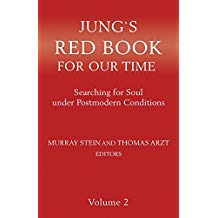

Jung`s Red Book for Our Time:
Searching for Soul Under Postmodern Conditions, Volume
2
Edited by
Murray Stein and Thomas Arzt
Reviewed by Henry Reed
God is dead, declared Frederick Neitze. How shall we bring God back to life, asked Carl Jung. Science had killed the imagination in favor of the senses. Where was a center of value? What is our story? Heisenberg pronounced the Indeterminancy Principal. If the observer affected the observed, what is the anchor on truth, on reality. The chaos of today's world situation, the amazing political situation in America, was long fortold. Today we are in the thick of it. What to do? On what to anchor ourselves? How to go with the flow? What has happened to the natural world we once were a part of, but now are alienated from just when we most need a healthy relationship to it? The curse of interesting times. The healing wound of the Postmodern era!
Carl Jung recogized our plight and had nightmares about it. Diving into his self-created therapy of active imagination, he set out to find God and see what could be done. If you ever have had a chance to watch the BBC movie on the life of Jung, there is a segment where he is asked if he believes in God. Jung hurrumphs slightly, and says something like, "I don't need to believe, I know!" Later in the movie we see his magnum opus, a hand calligraphed beautifully illustrated book. It inspired many of us to begin our dream journals and include pictures. It was called The Red Book. It wasn't seen afterwards, kept as a family item.
Decades later, in 2009, Sonu Shamdasani came out with the publication of the Red Book. It included a translation of the German, as well as a photo reproduction of Jung's hand made Red Book. The editor also gave the history of this project and described how Jung first did his active imagination in some black books, then transcribed them formally into the Red Book and added the pictures. He also spells out the intent and contents of Jung's opus, an attempt to heal the God that was dead.
Having the contents of the Red Book finally in the public sphere, available for study given the editor's roadmap, has created quite a stir. The result, less than a decade later, is the compilation of various reactions to the Red Book and its significance for our time. I had previously reviewed the first volume, which you can read at http://intuitive-connections.net/2018/book-jung-red-book.html.
Similar to the first volume, this one has 18 essays, written from a variety of Jungian perspectives on different current themes as viewed from the Red Book. Althoug the first volume has a lengthy introduction that explains the history of the Red Book and the project, there's a brief recap in the second volume, which truly stands on its own. Questions of how to live in a world of alt-truth, how the archetypes of renewal and revolution are afoot today and how Jung embraced them, and what we might do. The esays, although about an old piece of literature, brings about a wealth of meaning that aids us in contemplating current events and our role in them.
Once again, one of Jung's most Paul Revere like actions, to me, was his insistence, his hollering loud and clear, "the psyche is real!" It is having quite a time of revolution these days and the reader will be surprised and the relevant linkage from the past to the present. We aren't here by accident!